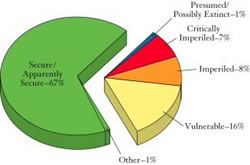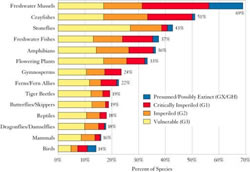Aquatic Biodiversity - the Variety of Life

Aquatic biodiversity can be defined as the variety of life and the ecosystems that make up the freshwater, tidal, and marine regions of the world and their interactions. Aquatic biodiversity encompasses freshwater ecosystems, including lakes, ponds, and reservoirs, rivers and streams, groundwater, and wetlands. The banks of streams or riparian areas are also important areas associated with freshwater systems. It also consists of marine ecosystems, including oceans, estuaries, salt marshes, seagrass beds, coral reefs, kelp beds, and mangrove forests.
Aquatic ecosystems also provide a home to many species including phytoplankton, zooplankton, aquatic plants, insects, fish, birds, mammals, and others. They are organized at many levels, from the smallest building blocks of life to complete ecosystems, encompassing communities, populations, species, and genetic levels. In summary, aquatic biodiversity includes all unique species and habitats, and the interaction between them.
Why is Aquatic Biodiversity Important?

Source: Precious
Heritage: The Status of Biodiversity in the United States© The
Nature Conservancy and NatureServe![]()
Aquatic biodiversity has enormous economic and aesthetic value and is largely responsible for maintaining and supporting overall environmental health. Humans have long depended on aquatic resources for food, medicines, and materials as well as for recreational and commercial purposes such as fishing and tourism. Aquatic organisms also rely upon the great diversity of aquatic habitats and resources for food, materials, and breeding grounds.
Factors including overexploitation of species, the introduction of exotic species, pollution from urban, industrial, and agricultural areas, as well as habitat loss and alteration through damming and water diversion all contribute to the declining levels of aquatic biodiversity in both freshwaterand marine environments. As a result, valuable aquatic resources are becoming increasingly susceptible to both natural and artificial environmental changes. Thus, conservation strategies to protect and conserve aquatic life is necessary to maintain the balance of nature and support the availability of resources for future generations.
The Nature Conservancy recently published the document Precious
Heritage: The Status of Biodiversity in the United States ![]() that illustrates the concerns with growing loss of aquatic biodiversity, as
indicated by the two figures presented on this page.
that illustrates the concerns with growing loss of aquatic biodiversity, as
indicated by the two figures presented on this page.

Source: Precious
Heritage: The Status of Biodiversity in the United States © The
Nature Conservancy and NatureServe![]()
The U.S. Environmental Protection Agency's Great
Lakes National Program Office (GLNPO) website has a document titled The
Conservation of Biological Diversity in the Great Lakes Ecosystem: Issues
and Opportunities, prepared by The Nature
Conservancy ![]() ,
which provides a good example of how loss of biodiversity can affect an ecosystem.
,
which provides a good example of how loss of biodiversity can affect an ecosystem.
"The health of the lakes and their biological diversity is directly related to the health of each component of the ecosystem. Similarly, the lakes are adversely affected when disturbances occur in one of the systems. For example, alterations in the upper watershed can impact the entire lake ecosystem. When a forest is cleared, not only is the physical structure of the terrestrial ecosystem altered, the tributary streams, coastal areas and the open lake can also be affected. When vegetation is removed near a tributary, precipitation is allowed to run off directly into the river or stream, causing flows in these streams to increase much more quickly (following rainfall). This run-off also picks up more soil than it otherwise would, and the load of sediment in the tributary will be increased. The increased sediments can destroy the habitat required by fish and insect species and can prevent the spawning of anadromous fishes which spend most of their lives in the open lake. These sediments can also accelerate the formation of sand bars and blockages at rivermouths, altering nearby coasts."
For more information:
- Visit NatureServe's Explorer
for up to date information on US biodiversity for plants, animals and ecosystems.

- Please view EPA's 2003 Draft Report on the Environment for "At-risk land and fresh water plant and animal native species in 2000" and EPA's 2007 Report on the Environment for Fish Faunal Intactness.
- Also see the Heinz Center report "State
of the Nation's Ecosystems" for more on "At
risk native species".
 Both of these reports are currently being updated.
Both of these reports are currently being updated.
![[logo] US EPA](https://cybercemetery.unt.edu/archive/oilspill/20120921191009im_/http://www.epa.gov/epafiles/images/logo_epaseal.gif)